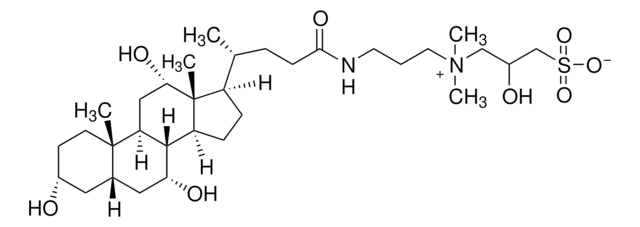C3023
CHAPS hydrate
≥98% (HPLC)
Synonim(y):
3-[(3-Cholamidopropyl)dimethylammonio]-1-propanesulfonate hydrate, CHAPS
About This Item
Polecane produkty
pochodzenie biologiczne
bovine bile
Poziom jakości
klasa czystości
HPLC grade
opis
zwitterionic
Próba
≥98% (HPLC)
Postać
powder
masa cząsteczkowa
614.88 g/mol (anhydrous basis)
warunki przechowywania
dry at room temperature (tightly closed)
metody
dialysis: suitable
electrophoresis: suitable
zanieczyszczenia
<0.04% DMF
CMC
8 mM
mp
157 °C (dec.) (lit.)
temp. przejścia
cloud point >100 °C
rozpuszczalność
water: 50 mg/mL
Warunki transportu
ambient
temp. przechowywania
2-30°C
ciąg SMILES
O.C[C@H](CCC(=O)NCCC[N+](C)(C)CCCS([O-])(=O)=O)[C@H]1CC[C@H]2[C@@H]3[C@H](O)C[C@@H]4C[C@H](O)CC[C@]4(C)[C@H]3C[C@H](O)[C@]12C
InChI
1S/C32H58N2O7S.H2O/c1-21(8-11-29(38)33-14-6-15-34(4,5)16-7-17-42(39,40)41)24-9-10-25-30-26(20-28(37)32(24,25)3)31(2)13-12-23(35)18-22(31)19-27(30)36;/h21-28,30,35-37H,6-20H2,1-5H3,(H-,33,38,39,40,41);1H2/t21-,22+,23-,24-,25+,26+,27-,28+,30+,31+,32-;/m1./s1
Klucz InChI
SJCUTFKCLFLIFE-JWTJKVBLSA-N
Szukasz podobnych produktów? Odwiedź Przewodnik dotyczący porównywania produktów
Opis ogólny
Widely utilized as a buffer in various research applications, CHAPS hydrate acts as an amphiphilic surfactant, proving effective in solubilizing plasma membrane proteins and diluting assay components. Notably, its easy removal through dialysis or gel filtration adds to its appeal, making it a preferred choice for molecular mass determination by fluorometry. This feature underscores CHAPS hydrate′s adaptability in diverse experimental setups. However, caution is advised in assays involving polyvalent metals or metal ions sensitive to nonspecific chelating agents. Beyond its conventional use, CHAPS hydrate finds application as a polymer matrix in binding assays, effectively removing metal ions from protein solutions.
Zastosowanie
Cechy i korzyści
- Suitable for Biochemical and Cell Biology research
- Can be used in Dialysis and Electrophoresis
- High purity product for research applications
Inne uwagi
produkt podobny
Hasło ostrzegawcze
Warning
Zwroty wskazujące rodzaj zagrożenia
Zwroty wskazujące środki ostrożności
Klasyfikacja zagrożeń
Acute Tox. 4 Oral
Kod klasy składowania
11 - Combustible Solids
Klasa zagrożenia wodnego (WGK)
WGK 3
Temperatura zapłonu (°F)
Not applicable
Temperatura zapłonu (°C)
Not applicable
Choose from one of the most recent versions:
Certyfikaty analizy (CoA)
Don't see the Right Version?
If you require a particular version, you can look up a specific certificate by the Lot or Batch number.
Masz już ten produkt?
Dokumenty związane z niedawno zakupionymi produktami zostały zamieszczone w Bibliotece dokumentów.
Klienci oglądali również te produkty
Protokoły
This page shows how to solubilize membrane proteins with products from Cytiva.
Na tej stronie przedstawiono sposób solubilizacji białek błonowych za pomocą produktów firmy Cytiva.
Nasz zespół naukowców ma doświadczenie we wszystkich obszarach badań, w tym w naukach przyrodniczych, materiałoznawstwie, syntezie chemicznej, chromatografii, analityce i wielu innych dziedzinach.
Skontaktuj się z zespołem ds. pomocy technicznej








